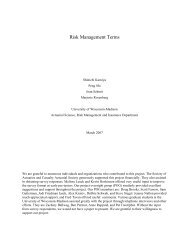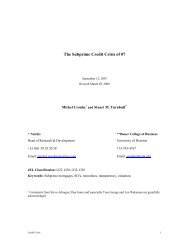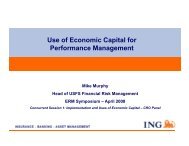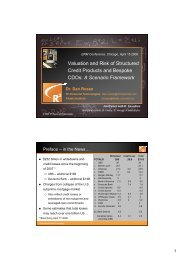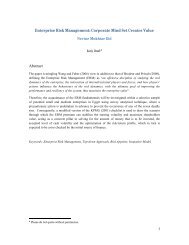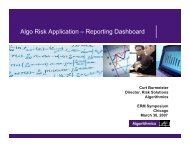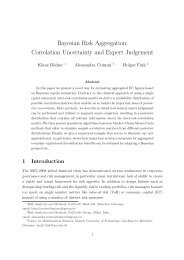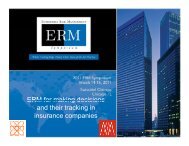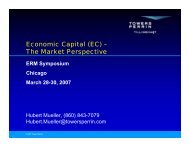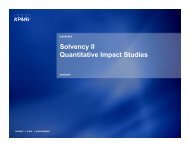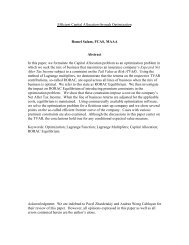An Empirical Map of Enterprise Risk Space for ... - ERM Symposium
An Empirical Map of Enterprise Risk Space for ... - ERM Symposium
An Empirical Map of Enterprise Risk Space for ... - ERM Symposium
You also want an ePaper? Increase the reach of your titles
YUMPU automatically turns print PDFs into web optimized ePapers that Google loves.
• Volatility risk<br />
(market risk)<br />
• Liquidity risk<br />
Part C illustrates the interaction between parts A and B.<br />
Data, Methodologies and Results<br />
• Incomplete contracts<br />
risk<br />
• Reserves risks<br />
6<br />
• Distribution risk<br />
• Regulatory risk<br />
• Legal risk<br />
• Globalization risk<br />
Since we are working with more than 150 variables, our discussion <strong>of</strong> the data is necessarily<br />
truncated. See the Appendix <strong>for</strong> summary statistics. We undertake the work in 4 steps as<br />
follows:<br />
Following Baran<strong>of</strong>f and Sager (2006), we first map the enterprise risk space <strong>of</strong> life insurers.<br />
Using accounting data <strong>of</strong> life insurers <strong>for</strong> 2003 the risk space is developed using a two-step<br />
methodology: (1) cluster analysis to group risk variables into related clusters, and (2) factor<br />
analysis to uncover the hidden dimensions <strong>of</strong> those clusters. We identified over 150 proxies <strong>for</strong><br />
risk variables in annual report data filed with the NAIC. The results shown here use year 2003<br />
reports <strong>for</strong> nearly 1000 life insurers, and then delete firms lacking in<strong>for</strong>mation or having<br />
anomalous data values, such as negative assets.<br />
Cluster <strong>An</strong>alysis Methodology<br />
The clustering algorithm that we used is hierarchical agglomerative in nature. Note that we<br />
cluster variables rather than insurers. Clustering begins with each risk variable in its own<br />
singleton cluster. It then joins the two risk variables that are most highly correlated. The<br />
algorithm proceeds in this manner, at each step merging the two clusters that are most highly<br />
correlated with each other. Thus, the number <strong>of</strong> remaining clusters is reduced by one at each<br />
step. Eventually the process ends with one super-cluster containing all the variables. By<br />
studying the history <strong>of</strong> the cluster mergers, one can identify a step in which all remaining clusters<br />
are relatively disparate. That step identifies an optimal set <strong>of</strong> clusters <strong>of</strong> risk variables. There is a<br />
degree <strong>of</strong> subjectivity in the selection <strong>of</strong> an “optimal” stopping point in the mergers, since cluster<br />
analysis is more an exploratory technique than a tool with a well-developed theory <strong>of</strong> optimality.<br />
Nonetheless, it can be quite helpful and illuminating. In addition, the analyst has the option <strong>of</strong>



